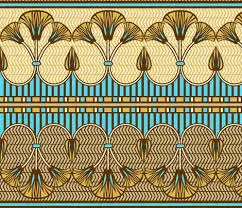Here are some facts about Egyptian patterns used:
The basic tool for the study and creation of repeated patterns is symmetry. Synonyms are rigid motion and isometry, which is often used to emphasize the defining property of symmetry, which is that symmetry is a distance-preserving transformation of the plane onto itself Familiar examples are rotation about a given point by a given angle, translation in a given direction by a given distance, and reflection in a given line.
Different Egyptian Patterns

Sacred Geometry is basically about geometrical shapes and patterns which have a sacred meaning. These shapes and symbols were very popular in ancient times. All forms of life in nature such as plants, seashells, or snowflakes have sacred geometry in their design and are good examples of sacred geometry in our everyday world.
The ancient Egyptian patterns were made with either bead, jewels, embroidery or painted leather pieces. But they also used colored glass so don’t be afraid to incorporate fake gems from broken costume jewelry. Glass and enamel were favorite techniques for decoration in the Land of the Pharaohs.
The famous vulture collar laid on the mummy chest of Tutankhamun was primarily inlaid with blue and coral red colored glass. The glass was possibly of high value as a product in itself in Egyptian eyes and was inlaid with the same solid gold as any other item encrusted with true precious gems. The birth of costume jewelry may have occurred in Egypt.
The Ankh was, for the ancient Egyptians, the symbol (the actual Hieroglyphic sign) of life but it is an enduring icon that remains with us even today as a Christian cross. It is one of the most potent symbols represented in Egyptian art, often forming a part of decorative motifs.
Decoration in Egyptian dress was chiefly confined to the collar. But if you just want to add a few Egyptian touches consider wearing simple decorative armband amulets.
The finite groups of symmetries of space are illustrated by the five regular polyhedra which were carefully constructed by Euclid in “The Elements”, and were seen by Plato to be essential to the basic structure of the universe. In the view of some these remarkable Greek contributions represent the beginnings of higher mathematics.
But, says Speiser, the discovery of the infinite groups of symmetries of the plane, as illustrated by the ancient Egyptian patterns, pushes back the beginnings of higher mathematics some 1,000 years further than previously recognized, to about 1500 BC.